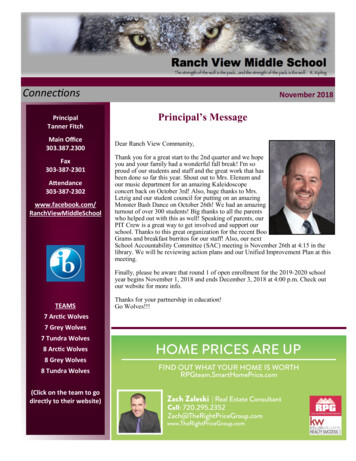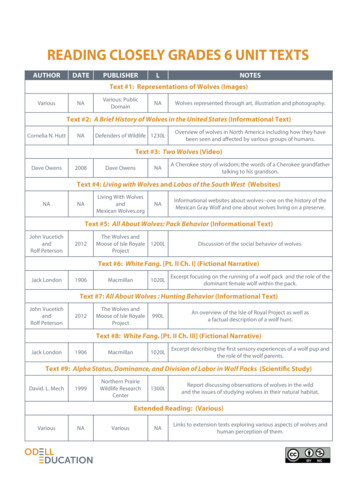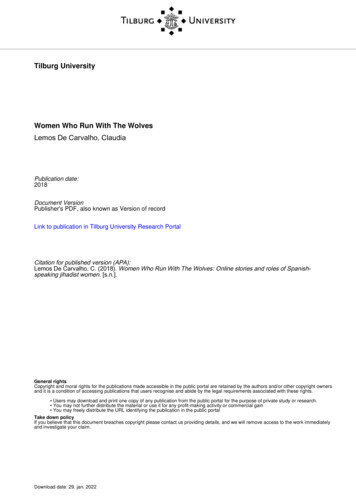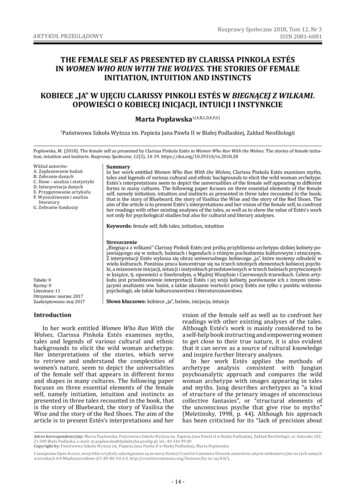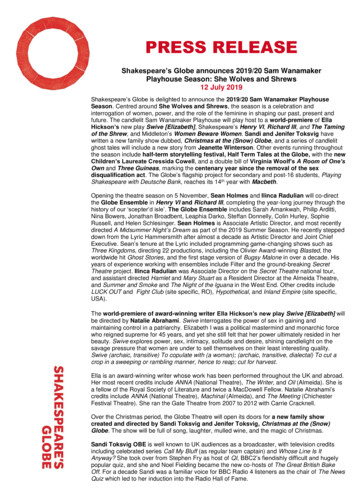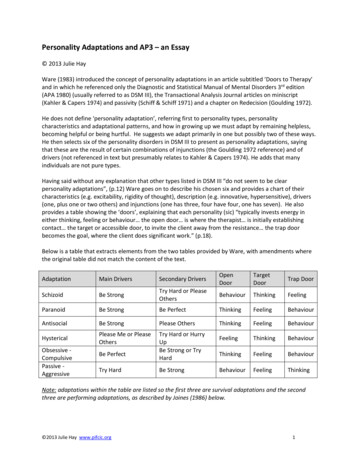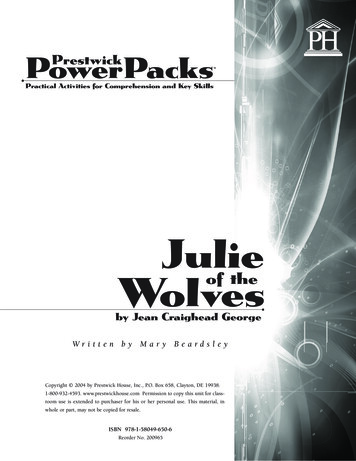
Transcription
PrestwickPowerPacks Practical Activities for Comprehension and Key SkillsJulieof theWolvesby Jean Craighead GeorgeWr i t t e n b y M a ry B e a rd s l e yCopyright 2004 by Prestwick House, Inc., P.O. Box 658, Clayton, DE 19938.1-800-932-4593. www.prestwickhouse.com Permission to copy this unit for classroom use is extended to purchaser for his or her personal use. This material, inwhole or part, may not be copied for resale.ISBN 978-1-58049-650-6Reorder No. 200965
Student’s PageJ u l i e o f t h e Wo l v e sP re s t w i c k P o w e r P a c k sName:Activity I:Connecting with Literature/PersuasionDate:Pre-ReadingImagine that you have been invited to take part in a wilderness experiment thatinvolves living alone in the wild. You may take two bags of supplies, no more than youcan carry. What would you take? How would you survive?Before you can answer these questions, you must decide what kind of wilderness youwill visit. Will you live in a forest, by a lake, on a beach, in a valley, on a glacier, orsomeplace completely different? Choose your location, and decide what you mustknow and bring with you to survive.Pretend you must convince your parents or guardians to let you go. You know they willask many questions about how you will survive safely. You will be more persuasive ifyou anticipate their questions and prepare thoughtful answers in advance. They willprobably ask questions like those in the Survival Chart. Fill in your responses to helpyou prepare for your parents’ or guardians’ questions. Then, add and answer two morequestions that you think your parents or guardians might ask.7Reproducible Student Worksheet
Student’s PageJ u l i e o f t h e Wo l v e sP re s t w i c k P o w e r P a c k sName:Date:Survival ChartWhat kind of wilderness will you visit?At what time of year will you make yourvisit?What kind of wild animals live there?What dangers will you meet?What will you need to protect yourself?What kind of tools will you need?Do you have any special knowledge orskills that will help you? For example,can you make a fire, build a shelter, huntand trap animals, or read animal tracks?How will you get food?How will you deal with loneliness?How long do you think you will survivein this wilderness before you have toreturn home?9Reproducible Student Worksheet
Student’s PageJ u l i e o f t h e Wo l v e sP re s t w i c k P o w e r P a c k sName:Date:Part I: Amaroq, the WolfActivity I:Context CluesPart I Pgs. 1-25Context clues help you determine the meaning of new words. These clues can be descriptions,actions and reactions, opinions, and direct definitions. They often appear in the same sentenceas the unfamiliar word, or within two sentences before or after it. In the example below, wewant to know the meaning of the word plaintive. We need to look for clues, such as descriptions, in the sentence:“The millions of voices of summer have all died down to one plaintive note.” (Pg. 130)“Millions of voices of summer” would be noisy. Imagine children during summer: they areexcited and loud, but the quotation says they have “died down.” That means they have quieted. Now, the sound is described as “one plaintive note.” The loud excitement of summer hasended. How do you feel when summer has come to an end? It is very possible that plaintivemeans calm and sad.Of course, if you cannot define a word using context clues, you should look it up in the dictionary to learn its meaning.Part 1The following vocabulary list contains Upick words and English words that describe Julie andthe setting. The author has provided context clues to help you understand their meaning.Included below are the page numbers where you will find each word.Look them up in the book, and match each vocabulary word with its context clues.Vocabulary Word1.2.3.4.5.6.7.8.9.heave (Pg. 5)Amaroq (Pg. 8)ilaya (Pg. 8)gussaks (Pg. 9)Lapland longspurs (Pg. 9)Ee-lie (Pg. 11)ulo (Pg. 12)lemming (Pg. 13)elated (Pg. 23)Context CluesA. “She clapped her hands at last breaking thewolf code”B. “ her heart skipped excitedly she called andscrambled to her feet.”C “my friend”D.“to eat these mice-like rodents”E. “one of many earth buckles that rise and fall”F. “the white faced”G.“wheel up into the sky, then alight in thegrasses”H.“the half-moon shaped woman’s knife”I. “wolf”11Reproducible Student Worksheet
Student’s PageJ u l i e o f t h e Wo l v e sP re s t w i c k P o w e r P a c k sName:Date:Part 2Now, use the context clues to write a definition for each word. Then, compare your definitions to the dictionary’s definitions to check their accuracy. Correct any of your definitions that contain errors. Note that you will probably not find the Upick words inthe dictionary, but they are directly defined by their context clues.1. heave:2. Amaroq:3.ilaya:4. gussaks:5. Lapland longspurs:6. Ee-lie:7. ulo:8. lemming:9. elated:13Reproducible Student Worksheet
Student’s PageJ u l i e o f t h e Wo l v e sP re s t w i c k P o w e r P a c k sName:Activity II:Date:Motivation/CharacterizationPgs. 1-25A.Pause and think: Julie is alone and lost in a very dangerous situation. She is hungry, has little hope of catching food on her own, and is vulnerable to predatoryanimals and the cold. As Julie, write a journal entry answering the followingquestions and explaining your actions. What has caused you to put yourself in this place? In other words, why are yourunning away? Where are you going? Do you regret running away? Explain.B.At this point in Julie’s life, she is trying to figure out who she really is. One of herbiggest problems is the influence of the “gussak” culture on her Inuit world. Inaddition to her use of the Upick language, Julie demonstrates her culture throughthe way she speaks, thinks, and acts.1. Who is Julie? Describe her age and her physical appearance.2. Look for actions and words that show Julie’s Inuit heritage. List as manyexamples as you can.15Reproducible Student Worksheet
Student’s PageJ u l i e o f t h e Wo l v e sP re s t w i c k P o w e r P a c k sName:Date:3.How does Julie feel about “gussak” values?4.Pretend that you meet Julie, and you can ask her any question about her culture.What question will you ask? Why will you ask it?5.What do you think Julie’s response to your question would be?6.What would you want to tell Julie about your own culture?17Reproducible Student Worksheet
Student’s PageJ u l i e o f t h e Wo l v e sP re s t w i c k P o w e r P a c k sName:Activity III: IllustrationsDate:Pgs. 1-25Illustrations frequently add to your understanding of the plot, characters, or setting ofa novel. Julie of the Wolves contains illustrations throughout. Look at the artwork onpages 2–3 and on pages 16–17.1.Pretend that the publisher wants to remove the illustrations. Write a letter to thepublisher telling why the sketches should remain in the book. Be sure to describehow the pictures help you understand the plot, the characters, or the setting. Thisis a business letter, which uses a special format. Use the Business Letter Modelas a guide.2.Now, create your own illustration of Julie’s shelter described on page 13. Make itcolorful and organized. Be creative! For example, you may draw it by hand, compose it on a computer, or construct a collage out of pictures from magazines.Business Letter ModelYour street addressYour City, State Zip CodeDateName of person to whom you are writingCompany nameCompany street addressCity, State Zip codeDear Sir or Madam (or the person’s name):In the first paragraph, introduce the purpose of your letter; for example, the lettermight try to persuade the editor of a book to insert or keep the illustrations in thenovel. Be courteous and brief. Business letters should contain only the necessaryinformation.In the second paragraph, support your point with explanation; for example,describe how the pictures help you understand the plot, the characters, or the setting.Sincerely,sign your name19Reproducible Student Worksheet
Student’s PageJ u l i e o f t h e Wo l v e sP re s t w i c k P o w e r P a c k sName:Date:Activity IV: PlotPgs. 1-25The plot of a novel is the sequence of events that take place within it, beginning withthe introduction and ending with the conclusion. The plot of a novel is divided intothe following sections:A.Introduction: the setting and the characters’ background information—namesand personalities; the introduction may be either descriptive or briefB.Conflict: the big problem that the characters spend most of the book trying tosolveC.Rising Action: smaller problems that the characters experience as they try tosolve the larger conflictD.Climax: the turning point; the most exciting, most suspenseful point in the novelE.Falling Action: the calming action and decrease in tension following the climaxF.Resolution: the conclusion of the story; the outcomeAt this point in the novel, you have discovered the conflict and moved into the risingaction. In small groups, complete as much of the Plot Outline as possible. Since youhave not reached the climax yet, you will leave some of the outline blank. You willrejoin your group and add to your outline after reading Parts II and III.STUDENT ROLES IN GROUP DISCUSSIONS1.Reader: The reader’s job is to read the questions aloud and to be sure everyone knowsthe meaning of unfamiliar words and understands the questions.2.Recorder: The recorder takes notes and is responsible for writing down the group’s finalanswers.3.Timer and Voice Monitor: The timer and voice monitor is responsible for remindingindividuals when they get too loud and for keeping track of the time. Because of a concern for finishing the project on time, the monitor will be the one to get the studentsback on task when they stray or get bogged down on one point.4.Checker and Encourager: This person’s chief responsibility is to encourage all membersto contribute, to compliment when appropriate, and to remind everyone of the necessity of avoiding name calling and/or put-downs.21Reproducible Student Worksheet
Student’s PageJ u l i e o f t h e Wo l v e sP re s t w i c k P o w e r P a c k sName:Date:Plot OutlineA.Introduction:B.Conflict:C.Rising Action:D.Climax:E.Falling Action:F.Resolution:23Reproducible Student Worksheet
Julie of the Wolves Prestwick PowerPacks Name: _ Date:_ 7 Reproducible Student Worksheet Student’s Page Activity I: Connecting with Literature/Persuasion Pre-Reading Imagine that you have be
